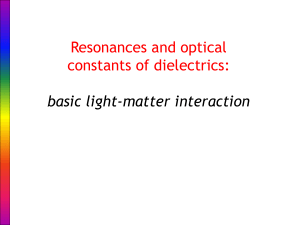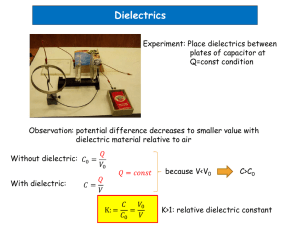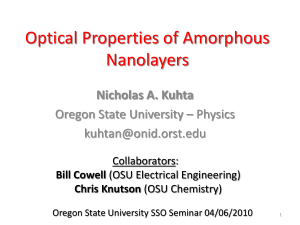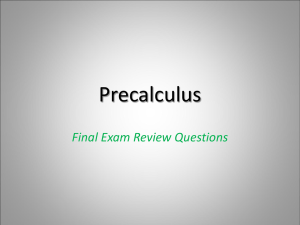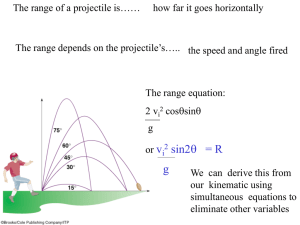chapt 3-복소유전율(최종-수정20130427)
advertisement
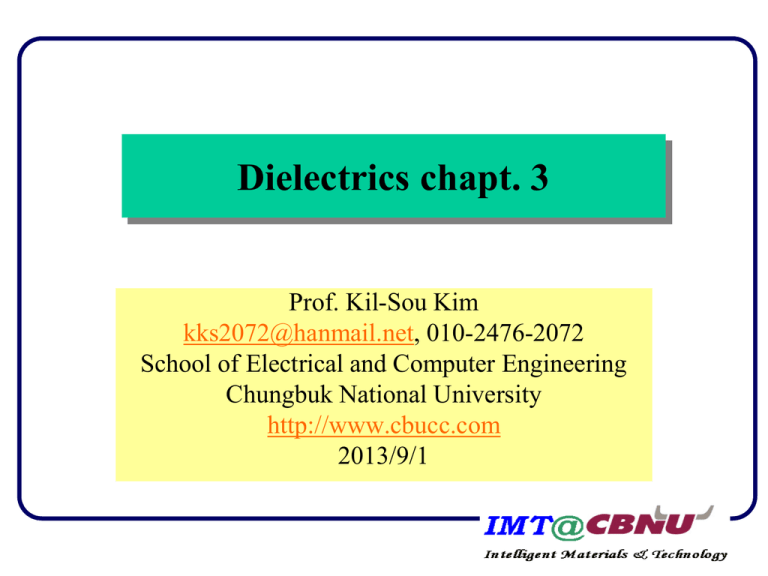
Dielectrics chapt. 3
Prof. Kil-Sou Kim
kks2072@hanmail.net, 010-2476-2072
School of Electrical and Computer Engineering
Chungbuk National University
http://www.cbucc.com
2013/9/1
Behavior of Dielectrics in Alternating Fields
• frequency dependence of the dielectric constant
• Complex quantity
• imaginary part is a measure for dielectric losses of materials
2
왜 AC하의 유전율은 복소수인가?
P 0 ( r 1) E
V RI
P(t ) 0 ( r 1) E(t )
V (t ) RI (t )
P(t ) 0 ( r* 1) E(t )
V (t ) ZI (t )
3
전자분극율의 주파수 의존성
x
E0
E
E
Harmonic oscillation (lossless)
d 2x
m 2 ax
dt
F e2 x / 40 R3 ax ( F : restoring force)
a
1016 rad / sec
x x0 sin(0t ) 0
m
Natural or resonance angular frequency lie in the ultraviolet part
4
전자파 방사를 고려한 경우(damping고려)
• 전자파 방사 고려, 전자의 가속도의 시간적 변화, 제동 항 추가
• 제동력(damping force)-속도에 비례
d 2x
dx
m 2 ax 2b
dt
dt
전계 E 인가
d 2x
dx
m 2 ax 2b
eE0 cost
dt
dt
A*
외력
내력
E0 cost Re[E0e jt ] E0 Re[e jt ]
x(t ) Re[ A*e jt ]
Re{[ 2 A*
a *
2b * e
A j
A E0 ]e jt } 0
m
m
m
5
(e / m) E0
02 2 j (2b / m)
(e2 / m) E0e jt
(t ) ex(t ) Re[ 2
]
2
0 j (2b / m)
(t ) Re[e*E0e jt ]
e2 / m
2
0 2 j (2b / m)
*
e
02 2
e2
2b / m
j [ 2
j
]
2 2
2 2
2
2
2 2
2 2
2
m (0 ) (4b / m )
(0 ) (4b / m )
*
e
'
e
''
e
Imaginary part : e"
Real part : e'
e"
0 : static value
0 : positive value
0 : negative value
=0
~ 0
~ 0
20
e2
e 2 ( ) / 20
2
2
2 2
2
m 40 ( ) 4b 0 / m
m ( ) 2 b 2 / m2
'
e
최대,최저; =+ - b/m
6
e"
and
=?
e 2b / 2m 20
( ) 2 b 2 / m 2
"
e
0 0
02 2 (0 )(0 ) 20
0
(e" )max e2 / 20b
1 "
( e ) max
2
7
Discussion on complex electronic polarizability
• Resonant type ; electronic and ionic polarizability
(relaxation type ; orientational polarizability)
• Resonant frequency ; 0 a m
– Electronic polarization – ultraviolet region
– Ionic polarization – infrared region
• Imaginary part of the polarizability gives rise to absorption of energy
by the system from the field ; “dielectric loss”
• In general an atom contains a number of electrons, each of them
corresponding to particular restoring force constant a i and a particular
damping constant bi. Consequently, the atom in general will have a
series of 0i values and the frequency dependence of electronic
polarizability are as follows.
8
3.2 ionic polarizability as a function of frequency
• 전자분극율과 이온 분극율은 유사한 형태의 주파수 의
존성을 보임
• 차이는 공진주파수가 적외선 영역임 ;1014 rad/sec
– 전계에 의한 음, 양이온의 상대적 변위
– 변위에 비례하는 복원력 존재
– 공진주파수( 0 a m ); 전자질량이 아닌 이온질량
• 이온분극율의 주파수 의존성은 Fig. 3.2의 전자분극율
의 주파수 의존성과 같은 형상이나 다만, 공진주파수가
적외선 영역임
9
3.3 Complex dielectric constant of non-polar solids
In case of AC field
In case of DC field
Ei (t ) E(t ) P(t ) / 3 0
Ei E P / 3 0
P(t ) N Re[(e* i* ) E0*i e jwt ]
P N ( e i ) Ei
P(t ) 0 Re[( r* 1)E0e jwt ]
P 0 ( r 1) E
( r* 2)
Ei (t ) Re[
E0e jwt ] Re[E0*i e jwt ]
3
Ei
j
'
r
3
E
r 1 N ( e i )
r 2
3 0
r* 1 N ( e* i* )
r* 2
3 0
*
r
r 2
"
r
10
3.4 Dipolar relaxation
(frequency dependence of orientational polarization)
Po (t ) Poet /
; Relaxation time
Po (t ) Po (1 et / )
Decay
Build-up
P
P (t ) 1
d
Po (t ) o e t / o [ Po () Po (t )]
dt
P
d
1
Po (t ) o e t / [ Po () Po (t )]
dt
Rate of change of Po with time =
1
(ultimate value- instantaneous value) x
11
d
1
Po (t ) [ 0 ( ro 1) E0 cos t Po (t )]
Po (t ) 0 Re[( ro* 1) E0e jwt ]
dt
1
Re[ j0 ( ro* 1) E0 e jwt ] Re[ 0 ( ro 1) E0 e jwt 0 ( ro* 1) E0 e jwt ]
ro 1
1
1
( ro 1)[
j
]
2 2
2 2
1 j
1
1
*
ro
Po (t )
0 ( ro 1)
0 ( ro 1)
E
cos
t
E0 sin t
0
2 2
2 2
1
1
In-phase
r 0 2 4a3
r 2 kT
Out-of-phase
저온
고온
12
AeH / kT
유전분산(유전율의 주파수 의존성)
• 공명형(resonant type)
– 전자 분극 ; UV 영역
– 이온 분극 ; IR 영역
• 완화형(relaxation type)
– 배향 분극 ; RF 영역
– 공간 전하 분극 ; kHz
– 계면 분극 ; 수 Hz ~ kHz
13
14
Interfacial and
space charge
Orientational,
Dipolar
r'
Ionic
Electronic
r''
r' = 1
ƒ
10-2
1
10 2
10 4
10 6
Radio
10 8
10 10
10 12
10 1 4
Infrared
10 16
Ultraviolet light
The frequency dependence of the real and imaginary parts of the
dielectric constant in the presence of interfacial, orientational, ionic
and electronic polarization mechanisms.
Debye’s theory
ro r
r 0 r
( r 0 r )
'
"
r
r
j
j
r
r
1 j
1 2 2
1 2 2
*
r
r 0 ; 배향분극 완화주파수보다 낮은 주파수에서 측정된 유전율
r ; 배향분극 완화주파수보다 높은 주파수에서 측정된 유전율
(
'
r
r 0 r
2
) ( ) (
2
" 2
r
r 0 r
2
)2
비유전율의 실수축(x-축), 허수축(y-축)을 가진 복소수 평면에 각 측
정 주파수에 따른 비유전율의 실수치, 허수치 도시하면 반원이 된다.
16
{ r' ( r (0) r ()) / 2}2 r"2 {( r (0) r ()) / 2}2
r* r ()
''
r
r ( 0) r ( )
0
2
r ()
r ( 0)
'
r
17
r (0) 2
r ( ) 2
r' r ()
r (0) r ()
1 2 02
[ r (0) r ()] 0
1 2 02
[ (0) r ()] 0
tan r
r (0) r () 2 02
r''
Debye model; semicircle
r (0) r ()
1 j 0
(empirical law)
Cole-Cole’s law ;원호(arc)
18
r
= 1/
= 3/
0
Semicircle
= 1/3
=0
r
O
rdc
r
Cole-Cole plot is a plot of r vs. r as a function of frequency .
As the frequency is changed from low to high frequencies, the plot
traces out a semicircle.
Ei
[보충자료]
B
0
H
A
0
x
0 Ei
B
P0
A
H
x
0 Ei
H / kT
e
d
(n1 n 2) ( P12 P 21)( n1 n 2) ( P 21 P12)n
dt
dn1
P12 n1 P 21n 2
dt
( H 0 Ei ) / kT
P12
dn 2
P12 n1 P 21n 2
dt
P 21
d
0 Ei
(n1 n 2) (n1 n 2)
n
dt
kT
e
e
(if
n1 n 2
02
1
m
0
Ei
n
kT 1 i
( H 0 Ei ) / kT
0 Ei kT
)
0 Ei / kT
P0 e
P0 e
0 Ei / kT
1
1
2 P 0 2
e
H / kT
_
순시분극까지 포함하면
r* 1 N
1
(
)
*
r 2 3 0
kT 1 i
2
0
액체를 대상으로 하는 Debye model과 동일
20
3.5 dielectric loss
• Ideal capacitor
– resistivity is infinite( displacement current only without
conduction current)
– Imaginary part of complex dielectric constant is zero
E (t ) E0 cost
2
J (t )
dD
0 r E0 sin t
dt
1
W (t )
J (t ) E (t )d (t )
2 0
2
1
1
2
E
sin
t
cos
td
(
t
)
0 r 0
2 0
4
2
0 r E02 cos 2(t )
0
4
2
0
Lossless !!
21
2
J
E
2
E
sin 2td (t )
0
r
0
0
• Capacitor with dielectrics I
– Conductivity of dielectrics is zero
E(t ) E0 cost Re[E0e jwt ]
D(t ) 0 E0 Re[ r*e jwt ]
J (t ) 0 E0 Re[( r' j r" ) je jwt ] 0 E0[ r" cost r' sin t ]
2
In phase
90 degrees out of phase
1
W (t )
J (t ) E (t )d (t )
2 0
2
0 r" E02
1
2
"
2
'
3
[
E
(
cos
t
sin
t
cos
t
)]
d
(
t
)
[
w
/
m
]
0 0
r
r
2 0
2
Dielectric loss !!
2 cos2 A 1 cos2 A
cos 2 xdx
sin 2 x
2
1
1
11
2
2
2
cos
td
(
t
)
(
1
cos
2
t
)
d
(
t
)
(
t
)
sin
2
(
t
)
2
0
0
2
22
등가회로(equivalent circuit)?
22
Dielectric loss
0 r' E0
Resultant current
E0
Dielectric loss tangent
r"
tan '
r
0 r" E0
• Origin of dielectric loss
– Radio frequency region ; dipole rotation, ion jumping
– Infrared region ; ionic vibration
– Optical region ; optical absorption associated with electrons
(F-center)
23
• Capacitor with dielectrics II
– Conductivity of dielectrics is not zero
Conduction
current density
dD
J (t ) E (t )
E0 Re[ e jwt ] 0 E0 Re[( r' j r" ) je jwt ]
dt
(E0 0 E0 r" ) cost 0 E0 r' sin t
In phase
90 degrees out of phase
Joule loss + dielectric loss
E
2
2
0
0 r' E0
0 r" E02
E0
2
0 r" E0 E0
24
25
절연체
• 절연체의 도전현상
– 표면 누설전류
– 내부 누설전류
• 절연체의 전기전도이론
– 이온결정 고체에서의 전기전도
– 기체에서의 전기전도
– 액체에서의 전기전도
• 절연파괴현상
• 절연파괴이론
– 고체, 기체, 액체
26
절연성 고체의 전기전도현상
• 표면저항(율)과 체적저항(율)
• 누설전류와 흡수전류
I
순시 충전전류
흡수전류
Il 누설전류
Ia
대전극
t
+
+
G
G
G
-
-
guard전극
주전극
Rv=V/Iv
Rs=V/Is
rv=Rv S/d [Wm] rs=Rs l/d [W]
27
실용재료에서 체적저항, 표면저항
• 체적저항
– 대표적인 고체 절연재; 합성수지
– 합성수지의 대부분은 공유결합
– 케리어 생성-원료의 제조 및 가공과정에서 혼입된 이온결합
성 물질, 재료의 분해 및 산화 등에 의해 생성
– 흡습이 되면 해리에 의해 케리어 증가, 저항 감소
• 표면저항
– 표면에 흡착된 물질, 이온결합성 물질+수분에 주로 좌우
– 표면 특성; 친수성, 소수성
– 부싱, 애자 등에서 중요한 특성
28
송전선 애자 표면저항 저하로 코로나발생
29
애자 표면저항 저하로 코로나 발생
30
이온결정에서의 전도이론
1
1
v fa exp[ (U qEa ) / kT ] fa exp[ (U qEa ) / kT
2
2
fa exp(U / kT )2 sinh(qEa / 2kT )
qEa kT
v fa exp(U / kT )qEa / kT
qEa kT
v fa exp(U / kT ) exp(qEa / 2kT )
J Nqv
a
v 1/ rv Nq(v / E)
U
log(1/ v ) log rv A / T log(T / B)
E
31
기체의 전기전도 현상
II영역;포화영역
I
I
-전극간에 발생된 전자, 이온 쌍이 전부
전극으로 흡인되면 전압을 증가시켜도
전류는 일정
II III
I s eqxs eq(d x)s eqds
V
I 영역; ohmic region
-기체중에는 우주선, 방사선 등에 의해 원
자가 이온화되어 전자, 이온 발생
-발생된 이온, 전자 들은 재결합으로 소멸
-공기중에는 일정량의 이온, 전자 존재
(이를테면 1m3당 109쌍 존재)
d
x
s +
q 쌍/m3 sec
III영역; 전류급증영역
- 전자 가속으로 충돌전리작용으로
케리어 급증
J (eN eN ) E
32
액체의 도전현상
• 액체의 분자배열은 기체와 같이 완전히 무질서한 상태도 아니고 고
체와 같이 규칙성을 갖는 것도 아님
• 이론적 취급이 가장 어려운 상태
• 특징
-
불순물이 포함되기 쉽고, 이온결합성 물질이면 해리되기 쉬우며 유전율이
큰 물질일수록 심함
- 기체의 전압-전류 특성과 유사하나 포화영역이 일반적으로 관측되지 않음
- 전류급증영역에서의 전류급증은 음극근처에 모여든 양이온에 의한 공간전
하로 전계가 강화되어 음극에서 전자방출이 용이해지기 때문임
- 오믹 영역의 저항율의 온도 의존성
log r ( / T ) log(T / b)
33
전기전도과정
1
r
ne
• Carrier(density; n)
– 종류 ; 전자(전자성 전도), 이온(이온성 전도)
– 기원 ; 유전체 내(유전체 자신, 불순물), 전극에서 주입
• Transport process(mobility ; )
– 전자
• 자유전자 가스 모델
• 에너지대 모델
• 호핑(hopping)모델
– 이온 ; 반응속도론 모델 일종의 호핑모델
34
절연파괴 현상
• 고체
• 기체
–
–
–
–
암류(dark current)
코로나(불평등전계하)
불꽃방전(과도기)
전로파괴
-절연파괴전압
-절연파괴강도
-내전압시험
-절연내력
• 아크방전
• 글로우방전
-절연파괴에 영향을 미치는 인자
* Paschen’s law
-Edge effect
-전극의 종류
Vs
-전원의 종류
-전압인가법
Pxl
-온도
35
기체 절연파괴이론
• Townsend 이론
– 전자의 충돌전리작용(작용)
d
J qN0e
전자의 충동전리작용과 양이온의 이차전자방출작용(g작용)
ed
ed
J qN0
qN0
d
1 g (e 1)
1 ged
d
ge 1
(불꽃방전 개시조건-Schumann의 조건식)
• streamer 이론
pl >200~500mmHg.cm 에서 적용
36
고체 절연파괴 이론
< 단시간 파괴 >
< 장시간 파괴 >
• 전자적 파괴
•방전 열화
•진성파괴
•코로나(corona)
•전자사태(avalanche)파괴
•트랙킹(tracking)
•Zener파괴
•트리잉(treeing)
•열적파괴
•전기화학적
•전기기계적파괴(맥스웰응
력)
* 2차인자
국부가열, 공간전하, 맥스
웰응력
37
(a) A schematic illustration of electrical treeing breakdown in a high voltage coaxial cable which
was initiated by a partial discharge in the void at the inner conductor - dielectric interface. (b) A
schematic diagram of a typical high voltage coaxial cable with semiconducting polymer layers
around the inner conductor and around the outer surface of the dielectric.
Some typical water trees found in field aged cables. (Left: Trees in a cable with tape and graphite
insulation. Right: Trees in a cable with strippable insulation.)
SOURCE: P. Werellius, P. Tharning, R. Eriksson,B . Holmgren. J. Gafvert, “Dielectric Spectroscopy for
Diagnosis of Water Tree Deterioration in XLPE Cables” IEEE Transactions on Dielectrics and
Electrical Insulation, Vol. 8, February 2001, p 34, Figure 10 ( IEEE, 2001)
Coaxial cable connector with traces of corona discharge; electrical treeing.
SOURCE: M. Mayer and G.H. Schröder , “Coaxial 30 kV Connectors for the RG220/U Cable: 20
Years of Operational Experience”IEEE Electrical Insulation Magazine , Vol. 16, March/April
2000, p 11, Figure 6. ( IEEE, 2000)
Tree and bush type electrical discharge structures
(a) Voltage, V = 160 kV, gap spacing d = 0.06 m at various times.
(b) Dense bush discharge structure, V = 300 kV, d = 0.06 m at various times.
SOURCE: V. Lopatin, M.D. Noskov, R. Badent, K. Kist, A.J. Swab, “Positive Discharge
Development in Insulating Oil: Optical Observation and Simulation” IEEE Trans. on Dielec
and Elec. Insulation Vol. 5, No. 2, 1998, p. 251, Figure 2.( IEEE, 1998)
Ebr
10
Intrinsic
Electronic
Electromechanical
1 MV cm-1
Internal discharges
and electrical trees
Thermal
100
Water trees
10
1 kV cm -1
1 ns
1 µs
1 ms
1s
1 min 1 hr1 day 1 mo 1 yr10 yrs
Time to breakdown
Time to breakdown and the field at breakdown, Ebr, are interrelated and depend on the mechanism that causes
the insulation breakdown. External discharges have been excluded (based on L.A. Dissado and J.C. Fothergill,
Electrical Degradation and Breakdown in Polymers, Peter Peregrinus Ltd. for IEE, UK, © 1992, p. 63)
절연설계 및 재료
• 재료 선정
• 절연설계
•절연특성(절연저항,내전
압 등)
•내전압 ; 정격전압 및 외뢰,
내뢰 등의 과도전압을 고려하
여 정함
•유전특성(저유전율,저유
전손실)
•기체
정격전압x2+1kV
•BIL(basic lightening- impulse
insulation level); IEC규정
• 진공, H2, SF6 등
•액체
• 광유, 합성유
•Partial discharge
•고체
•발생전압, 소멸전압
•무기재료
•유기재료(polymer)
•복합재료
•특정전압에서의 Qmax
44
친환경(eco-friendly) 전력기기 동향
1. 국제 환경규제
2. 대응
1972; UN환경선언(UN 환경회의)
1989;몬트리올 의정서(오존층파괴물
질 금지)
1991;리우선언-Agenda21(지속가능개
발)
1995;ISO14000(환경경영시스템)
1996;WTO(환경과 무역 다자간 회의)
1997;Kyoto protocol(지구온난화 물질
감축)
2000;WEEE, RoHS, EUP directives
(전기전자제품에 대한 직접규제)
45
-정부; 기후변화협약대책위(국
무총리), 에너지관리공단 기후
대책총괄실, 기술개발지원, 법
제화
-산업체;친환경제품 개발
유해물질free제품
Recycle 가능제품
환경부하 낮은 제품
-신 환경산업 대두
Kyoto protocol
• 주 내용(지구온난화물질 감축)
•온실가스(6종); 이산화탄소, 메탄
(CH4), 아산화질소(N2O),불화탄소
(PFCs),수소불화탄소(HFCs),육불화
황(SF6)
•38개국선진국2008년부터 2012년까
지 배출량 ’90년대비 평균 5.2%저감
•개도국2013년부터 2017년까지 감축
(한국)
•온실가스 배출권의 국가간 거래허
용(ET;emission trading)
•CDM(clean development mechanism)
•JI(joint implementation)
46
•온실가스 배출량 및 온난
화기여도
•2002년; 510백만톤CO2
•CH4 21/15
•N2O 310/6
•CO2 1/55
•PFCs, HFCs, SF6
1300~23900/24
•1 ton CO2 = 23EUR(’06.5 현재)
